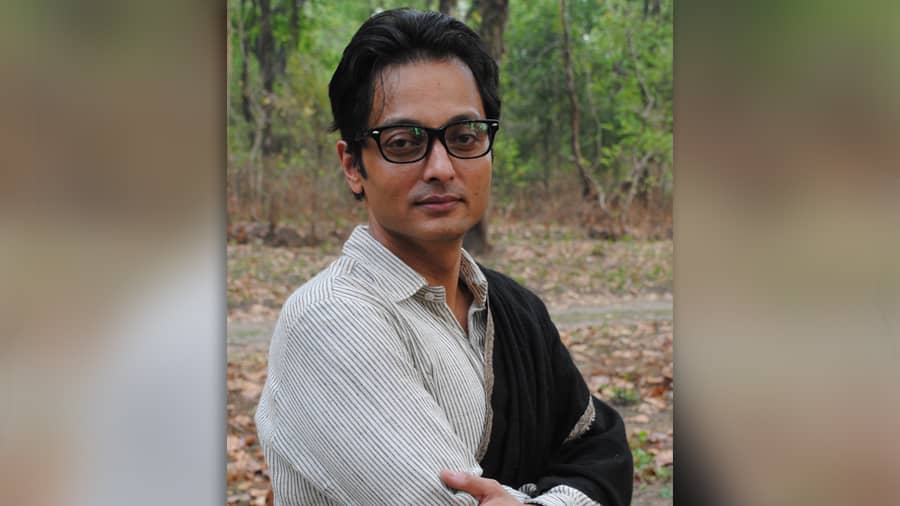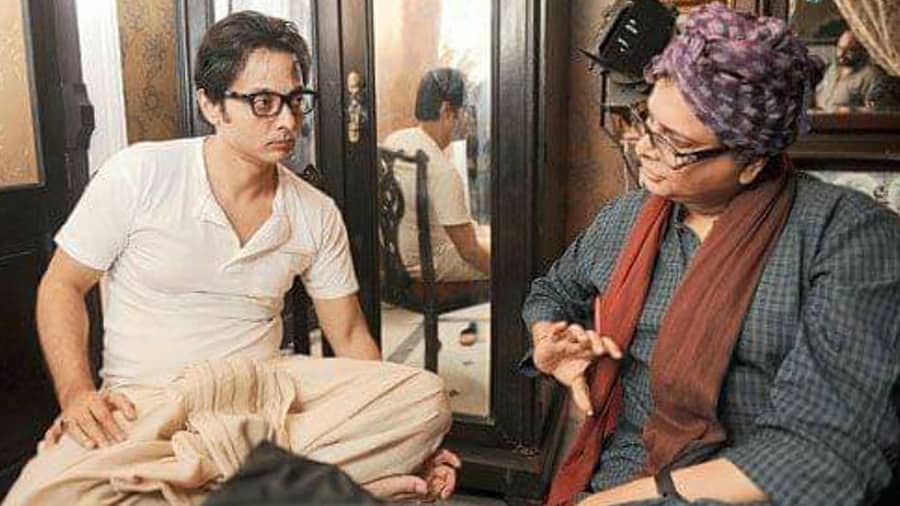Both in life and in his work, Rituparno Ghosh had denounced the binary. His personal mirrored his professional. Because his films were an extension of him, even today — as when they were released — Rituparno Ghosh’s films remain fresh, personal and honest. Even today, they remain ahead of their time.
A young Rituparno started his journey as a filmmaker a year after the death of another legend, Satyajit Ray. Rituparno’s initial few days and Ray’s last few days had seen similar sensibilities in filmmaking. They belonged in the same world. However, Rituparno was yet to find his distinct personal voice, for which he became iconic.
Over the next decade and more, Rituparno’s filmography matured, his intelligent scripts attracted high-profile stars from Bombay, and he managed to, in his own way, erase the dreaded line that divides the art house from the mainstream. Rituparno perhaps even more than his predecessors, barring Ray, integrated his niche artistic sensibilities in a more mainstream setup, casting actors who otherwise were on their individual journeys to become stars and producing films with Shree Venkatesh Films, who even back then represented the almost monopolistic nature of studio filmmaking in Bengal.
A choice that came as a shock
One film that sticks out in Rituparno’s filmography is his last — 2013’s Satyanweshi. Upon release, Satyanweshi received mixed to negative reviews. The blame wasn’t put on Rituparno, however, as he had passed away during the post-production of the film, which meant a lot of the creative decisions were left to the editors, producers and post-production team. There’s enough reason to believe that had Rituparno been in charge till the end, maybe the audience would have witnessed a better film. We’ll never know. However, what was most interesting about the film was Rituparno’s Byomkesh and his choice of the actor — Sujoy Ghosh, a choice that came as a shock to both the audience and the actor-director himself.
Sujoy Ghosh in 2013 was a well-known name. He had released his directorial Kahaani, a year back, starring Vidya Balan, and received praises from audiences across the nation. Despite appearing in small roles in films before — where his presence is almost forgotten — ‘actor’ isn’t what one would’ve used to describe Sujoy Ghosh. But he took up the challenge.
Now, it’s important to note that Satyanweshi wasn’t Rituparno’s first attempt at Byomkesh Bakshi. He had purchased the rights for three of the novels based on the detective. Prosenjit Chatterjee was roped in to play Byomkesh Bakshi. However, they weren’t the only ones. It was the start of what one could call a wave of Bakshi films. After the forgettable Magno Mainak by Swapan Ghoshal, Anjan Dutt launched his own Bakshi franchise starring Abir Chatterjee as the sleuth. The quick acceptance of Dutt’s Bomkesh Bakshi from the first look itself, and the announcement of many other films based on the character derailed Rituparno’s plans to create his own version of the sleuth. In 2009, Rituparno and Prosenjit decided to shelve their film.
Had Rituparno and Prosenjit made their Bakshi film, it would have mirrored a similar power play to Satyajit Ray and Uttam Kumar’s attempt with Chiriyakhana. The generation’s top director and the top actor collaborating to create the truth seeker. But that would have been a very different film from what was eventually made.

Sujoy Ghosh as Byomkesh Bakshi in Rituparno’s Satyanweshi. IMDb
Sujoy Ghosh: A polar opposite to the Byomkeshs before him
Sujoy Ghosh — the actor — was polar opposite to everyone before him. In public consciousness, the three Byomkeshs were Uttam Kumar, Rajit Kapoor and Abir Chatterjee. Their confidence and body language were fuel for their story to move forward. Not just that, the three Byomkeshs relied heavily on physical performances to bring out the character.
Sujoy was different. Both the man and the character were sensitive, soft-spoken and sometimes even passive. He was a keen observer, an acute listener and an everyday man. Rituparno and Sujoy’s Byomkesh Bakshi wasn’t tall, handsome and traditionally street smart. Rituparno’s Bakshi paralleled the men in his earlier films — complex, sensitive and believable.
For the longest time in literature and film adaptations of them, detectives are perfect individuals without internal complexities who make little to no mistake. And should they make mistakes, it gets resolved quickly. Detectives in literature and film are adventurous, aggressive if needed and skilled at, well, everything.
A large section of detective literature is aimed for children. Sharadindu Bandopadhyay’s Byomkesh Bakshi, however, not so much. In fact, Bandopadhyay ditched cliche tropes of detectives such as them being loners or single or misunderstood / hard-to-understand men. Byomkesh was a family man, a man with friends and someone you could imagine sitting down for adda over a bhanr of chai to converse about everything from politics to literature, without being sermonised. A large part of its film adaptations never quite tapped into it. Rituparno highlighted it.
This Byomkesh is not a lone wolf; he’s a team player
From the beginning, Sujoy Ghosh’s Byomkesh doesn’t fit the traditional detective cut-out. Yes, he’s physically passive but he’s always thinking, always theorising. His eyes move constantly. And he speaks not to conclude, but to theorise. When we first see Byomkesh in the train with Ajit (played by Anindya Chatterjee), he’s an intelligent bookish Bengali who seems to enjoy the company of his friend. Ajit and Byomkesh are playful with each other here, often teasing while sharing a warmth and trust for one another.
Byomkesh meets his friend, Himangshu (played by Indraneil Sengupta). With him, too, Byomkesh is friendly and playful. Sujoy Ghosh’s body language isn’t rigid or defensive. It’s welcoming. He allows the friendship, the reconnection with Himangshu. Byomkesh is a truth seeker who’s there to solve a case, sure, but he’s also Himangshu’s friend. It’s a complicated relationship. In the hands of any other director, Byomkesh’s objective would have been binary. In the hands of Rituparno, it wasn’t. For Byomkesh was solving the case slowly by using the friendship, the affection, the sense of humour. It’s not one or the other for Rituparno and Sujoy. It’s an integration of both.
Sujoy’s Byomkesh isn’t a lone wolf. He’s a team player. There are many instances in the film where he treats Ajit as an equal, rather than an echo chamber for his validation. The character doesn’t want the spotlight. Byomkesh wants the truth and if there’s a way Ajit can help, he should be given the complete freedom to get to the truth in his own way. A truly refreshing dynamic in a detective film, where sidekicks are there merely for narration, comic element or to enhance the detective’s smartness.
What Satyanweshi might have been…
Sujoy’s Byomkesh is still one of the more refreshing performances of the character till date. Apart from Sushant Singh Rajput’s young and arrogant Byomkesh in Dibakar Banerjee’s Detective Byomkesh Bakshy!, the other iterations of the character in the 2010s have been unfortunately very similar to one another, with little to no originality from either the actor or the director’s part.
A lot was said about the poor acting in the film after its release, especially of the protagonist played by Sujoy Ghosh. Let me make a case for Ghosh and Ghosh here. ‘Good’ screen acting is teamwork. Merely good acting on set doesn’t make acting on screen look good. Editing is paramount in bringing out nuances in performances. Once that is done, comes dubbing — where the dialogues are recorded later in a studio — sound design and sound mixing. Together, these different steps integrate to create an illusion of a flawless performance. In Satyanweshi, Sujoy Ghosh acted brilliantly on set. But that was about it. Perhaps Rituparno’s presence would have made a lot of difference in the edit and the sound mix. As already mentioned, we’ll never know.
But it has been nine years since Satyanweshi released. It’s worth revisiting. The film has aged well with time and stands above a lot of mediocre attempts made since then. Maybe someday, like Hollywood often does, the film could get a re-edit and re-mix, allowing us to truly appreciate Ghosh and Ghosh’s Bakshi for what it truly is — brilliant.

